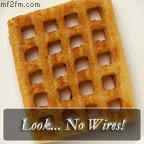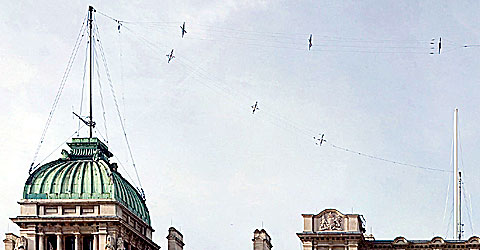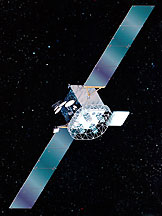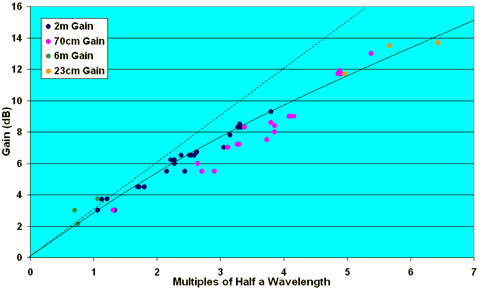Thursday 20 September, 2007, 10:10 - Much Ado About Nothing
Posted by Administrator
Wireless Waffle isn't one of a kind. There's another Wireless Waffle on the web. Whilst I claim no originality for the title of this blog, it does irk me that the man who runs the other Wireless Waffle is so upset that I accidentally stumbled across the same name as him that he feels the need to take a poke at this site on many occasions.Posted by Administrator
 When I first launched this site, Keith, who runs the other Wireless Waffle, contacted me with a nice e-mail and suggested that we exchange links. I put up a link to his site with a nice button that I took time to make myself (see right) but when a reciprocal link failed to materialise on his site I took it down, and thought nothing more of it. But putting 'Wireless Waffle' into Google, I recently noted that the <title> of his site has been changed to:
When I first launched this site, Keith, who runs the other Wireless Waffle, contacted me with a nice e-mail and suggested that we exchange links. I put up a link to his site with a nice button that I took time to make myself (see right) but when a reciprocal link failed to materialise on his site I took it down, and thought nothing more of it. But putting 'Wireless Waffle' into Google, I recently noted that the <title> of his site has been changed to:Wireless Waffle - A fine radio site not the blog copying its title
If that's not enough, the description of his site says:
Wireless waffle is a specialist radio site ... it is not to be confused with the blog which is using the same title - this other site is more technical and whilst we do not have the copyright on the word waffle they could have thought of a different title...
Fair enough, I could have thought of a different title, but I didn't, but neither did I specifically pick the name on purpose to upset anyone. I was not aware of Mr. Knight's site until he sent me an e-mail.
But the rhetoric doesn't stop there. In a post he made on his site on 16 September he says,
I am wondering if you would miss the Wireless Waffle site if I decided to close it? ... There is another site, a blog, which insists on calling itself Wireless Waffle which is far more technical than this. The chap who publishes this has pictures of ladies in various poses and states of undress. I am one of those that favours proper websites rather than blogs. Blogs do not demand any knowledge of html and that is part of the fun of operating a site.
Now this is just downright misleading, and in some cases completely wrong. He is insinuating that:
 * My use of the occasional saucy picture demeans the content on this site. There are many pictures of men in various states of dress as well as women and anyway this kind of thing has been adorining British seaside postcards for many years. These pictures, with their associated captions are intended to add some levity to what can be rather colourless topics.
* My use of the occasional saucy picture demeans the content on this site. There are many pictures of men in various states of dress as well as women and anyway this kind of thing has been adorining British seaside postcards for many years. These pictures, with their associated captions are intended to add some levity to what can be rather colourless topics.* That my use of 'blog' software to publish the articles I write devalues them. I use blog software as it makes presentation look nice and it's easier to find articles and for people to browse around.
* That I know nothing about HTML. This couldn't be further from the truth. Take a look at the other content on the host site for Wireless Waffle, such as my Javascript tools, or my Random Town Name Generator. All of these are written by me, using nothing more than a text editor, and most pages are in XHTML which is notoriously more difficult to write in than HTML. If you're going to level that kind of accusation at someone, at least make sure your own site is valid HTML!
The most serious accusation is that by starting this site, I have damaged the viewership of his site to the extent that he is, in essence, accusing me of forcing him to close his site down.
The reaction of many people to so many unfounded accusations might be to retaliate, but I'm not that kind of person. Mr. Knight's site is an interesting read with content that most of the readers of this site would no doubt find of passing or of direct interest. I suggest you take a visit (click on the button above) and have a look around. And pop back here afterwards and leave a comment on this post to let me know what you think.
5 comments
( 2224 views )
| permalink
| 



 ( 3.2 / 26875 )
( 3.2 / 26875 )




 ( 3.2 / 26875 )
( 3.2 / 26875 )
Tuesday 11 September, 2007, 14:07 - Radio Randomness
Posted by Administrator
OK, so it's not as snappy as 'spot the ball' but the idea is the same. Look at the picture below and see if you can spot the HF antenna. Clue: Look for the 'x's.Posted by Administrator

A bit silly perhaps, but the thing of interest is that this building is the Admiralty Building as seen from Horseguards Parade in Central London and that those really are HF antennas (see the expanded picture below). Whilst it's easy to dismiss good old fashioned short wave communications as outdated, especially in the age of satellites and mobile phones, it's very satisfying to see that those who need some assuredness of communication think it worthwhile to defile historic buildings in the centre of an area of tranquility and beauty with whopping great big, ugly HF aerials.

It doesn't necessarily follow, but it might be fair to presume that the people who did this (let's call them the 'military' for want of a better word) will be keen to ensure continued, low-interference access, to HF spectrum for some time to come. Which has to be good news for short-wave listeners and radio amateurs alike.
Friday 31 August, 2007, 10:48 - Pirate/Clandestine
Posted by Administrator
Since the late 1990's rumours have abounded that it was possible to hack into American military satellites and use them for wide area communication. The satellites, originally the 'FleetSatCom' newtork (often abbreviated to FLTSATCOM) use basic FM modulation and have uplinks in the area of 300 MHz and downlinks in the area of 260 MHz. Stories went that tuning in to the downlinks it was possible to hear illegal pirates, from Brazil in particular, who were usurping these US military satellites to use for wide-area communications. It was also said that 'Smile 93.9 FM' (rumoured to be from Manila) was using one of the channels as a studio to transmitter link and could often be heard on the downlink frequency of 269.950 MHz.Posted by Administrator
This seemed a little far fetched and unbelievable: How could one of the world's most super-sophisticated armed forces allow their multi-million dollar military hardware be taken control of by such an unsophisticated enemy armed with nothing more than a simple UHF FM transmitter? Using a simple VHF/UHF receiver and a bog standard roof mounted VHF/UHF antenna, I set out to try and debunk the myth.
Within seconds I was listening to a conversation between two likely sounding chaps on a frequency of 255.550 MHz. Next I stumbled across more voice traffic (definitely in Portuguese, the language spoken in Brazil) on 258.650 MHz. And before long I found more voice traffic on 253.850 MHz. Intrigued that this long reported phenomena was still in evidence I did a bit of digging on the internet to find out more.
The original FleetSatCom satellites which were launched in the late 1970's and early 1980's are no longer operational. They were initially replaced by satellites known as Leased Satellites (Leasat) which have also since been replaced by the UHF Follow-On series of satellites, ironically acronymised as UFO. The UFO satellites continue to provide the same communications capabilities as the earlier ones but with somewhat higher transmitter powers, making reception of them fairly straightforward.
A bit more digging uncovered military standard MIL-STD-188-181A which describes the interface specification for the satellites (i.e. the technical requirements for equipment used to access them) and in it we find a list of the uplink and downlink frequencies used. All the frequencies I could hear are in group 'Charlie', now known as group 'Quebec' (Q) on the UFO satellites. Group Q comprises the following 25 kHz wide downlink frequencies (uplink frequencies are 41 MHz higher):
 Q1 250.650 MHz (Fleet Broadcast)
Q1 250.650 MHz (Fleet Broadcast)Q2 252.150 MHz (Navy Channels)
Q3 253.850 MHz
Q4 255.550 MHz
Q5 257.150 MHz
Q6 258.650 MHz
Q7 265.550 MHz
Q8 267.050 MHz
Q9 269.450 MHz
Q10 269.950 MHz
Q11 260.625 MHz (DoD Channels)
Q12 260.725 MHz
Q13 262.125 MHz
Q14 262.225 MHz
Q15 262.325 MHz
Q16 262.425 MHz
Q17 263.825 MHz
Q18 263.925 MHz
So far, I have heard sporadic voice traffic on channels Q2, Q3, Q4, Q5 and Q6 and something, albeit rather weak on Q7. It seems as if the satellite I am hearing is UFO-7 which is situated over the Atlantic. But is this traffic really pirates using the satellites on purpose, or is it something else? Surely there is no longer the need, in Brazil or other countries, to use US military satellites for communications, especially now that mobile phones and mobile coverage are virtually ubiquitous?
A quick look at the Brazilian frequency allocation table, the Plano de Destinação de Faixas de Freqüência, shows us that the frequency range 270 - 326.8 MHz is assigned to the fixed and mobile service, and in particular to public correspondence. So the frequencies are quite legally in use for various communication services; could it be that they are being relayed by the satellite is incidental and a result of the fact that the uplink frequencies are used differently in different parts of the world? So maybe there are no Brazilian pirate radio mafia trying to jam US military satellites after all then? What a shame, it seemed like such a good story.
Tuesday 31 July, 2007, 21:26 - Radio Randomness
Posted by Administrator
Anyone who really knows their stuff when it comes to radio propagation and the like will tell you that any aerial (or an antenna for that matter) has a certain capture area. Posted by Administrator
 Its capture area defines, in effect, how much of the signal that is in the ether it can capture and thus present to an attached receiver. The bigger the aerial, the greater its capture area and the stronger the received signal. Obvious really.
Its capture area defines, in effect, how much of the signal that is in the ether it can capture and thus present to an attached receiver. The bigger the aerial, the greater its capture area and the stronger the received signal. Obvious really.For some antennas, such as satellite dishes, the capture area is relatively obvious. A satellite dish which covers an area of 1 square metre has a capture area of roughly 1 square metre (ignoring edge effects). For linear aerials, however, the capture area is less obvious. Which has the greatest gain - a 4 element yagi or a 4 wavelength long colinear? Not so easy is it. However, it seemed to me that there ought to be a simple rule-of-thumb which allowed simple comparison between antennas. So let's therefore hypothesise that:
- The gain of a linear aerial ought to be somehow related to the amount (length) of metal it represents. Thus if you add up the length of the elements on a yagi and stretch them out into a colinear, the two should have the same gain.
- A doubling of the amount (length) of metal should double the overall gain (i.e. increase it by 3dB).

The dotted line represents the hypothesis - i.e. that the gain rises by 3dB for each doubling of length. The solid line represents a 'best fit' line. As the antenna gets long (in terms of wavelengths) there is a noticeable drop in gain with respect to the hypothesis. It is probable that as the antennas become long, the losses in the 'metal' itself cause a fall in total gain, away from the the theoretical figure. Alternatively the hypothesis is incorrect. Either way, the original premise isn't that far off!
The next job is to see whether the hypothesis about the total length of elements of a yagi and the length of 'wire' in a a colinear holds any water.


